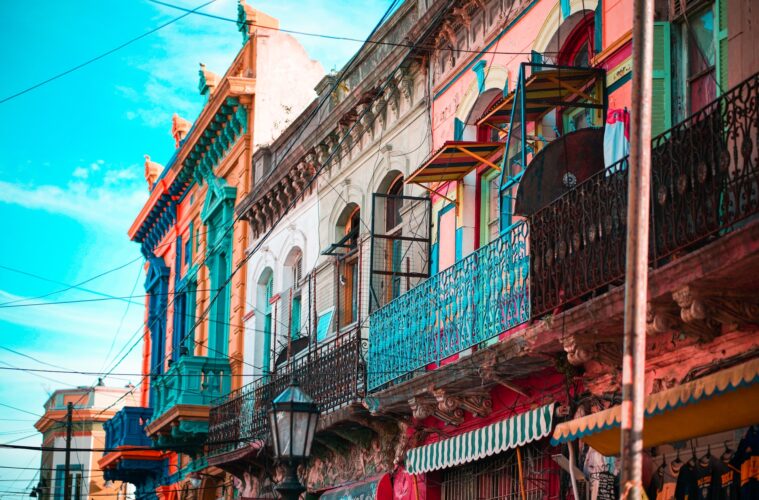Buenos Aires is the capital and largest city of Argentina. However, this iconic South American metropolis has a very European flavour and look to it…
WORDS BY: TRAVEL THE WORLD AND SMILE HAPPY TRAVELLING WITH DAVIE
It sits on the banks of the River Plate and is made up of a number of distinct neighbourhoods, or as they’re known locally; barrios, each with their own culture and charm.
Despite its size the city is in fact easy to explore and navigate for us visitors, either on the Subte metro system or in fact on foot by walking its colonial style large avenues and boulevards. On a personal level I would describe Buenos Aires as resembling in terms of architecture a cross of two classic European cities those being Paris and Madrid. But what it does have is its own unique South American vibe and beat.
Arriving in Buenos Aires
The majority of tourists will arrive in the city by air and the cities main international airport is 20 miles outside the city center the MINISTRO PISTARINI INTERNATIONAL AIRPORT. The main way to travel from the airport to the city is by taxi or pre-booked private hire transfer. The journey takes approximately 50 minutes depending on traffic.
There is also the option of using the bus services that run to and from the airport. However, if you’re visiting for the first time I would recommend a pre-planned transfer.
Cruise Port
A number of cruise ships now include Buenos Aires on their itineraries with many cruises starting or ending there. The city does have a cruise terminal called the Quinquela Martin Terminal. However, having personally experienced this terminal lets say it is at best described as “basic”!!!
Embarkation’s and disembarkation can be a little stressful and at times chaotic so be aware it can take some time to complete both.
The terminal is small, and the real problem is the port is a extremely large industrial one. So, you don’t dock at the Terminal your Quay is inside the port. Which means you are taken to and from the ship by shuttle buses through a very busy working port area.
One last recommendation and I cannot stress enough if your arriving or departing here – make sure you don’t walk outside the Terminal carpark area, make sure you get a taxi transfer to your hotel, simply put the area directly outside the port gates is not the best and NOT tourist friendly so get that taxi.
Where to stay?
To answer this you have to remember your in the capital city of Argentina so in terms of hotels you’re not going to be short of options. All the major international brands have options here as well as a host of others giving you a wide range to suit all budgets.
So, the main consideration would be in what area of the city you would want to base yourself for ease of travel, availability of restaurants and bars, and of course safety for you as a tourist.
I would offer 3 choices and will give my reasons for my recommendations:
1, The City Centre
Ok sounds sensible and it is, as it has all the services, and is in fact close to most other neighbourhoods (with the exception of Palermo). The downside is it can get extremely busy particularly during the day and after dark is a bit impersonal.
2, Puerto Madero
Within walking distance of the centre and is very safe good area to enjoy a walk. It has many excellent restaurants on its waterfront to choose from. Downside: little public transport, and it can be expensive.
3, Congreso & Tribunales
Reasonably central and has some interesting classic architecture and good cultural vibe, in the local theatre district. Downside: few eating and shopping options in the area and it can get edgy at night.
What to see and do
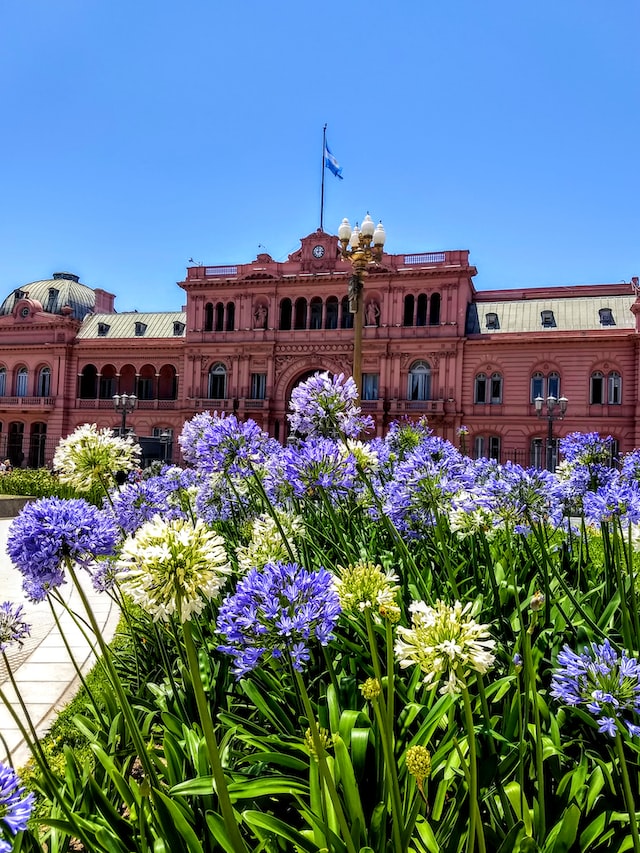
Plaza de Mayo | Buenos Aires
Plaza de Mayo
Possibly the most famous location in the city, if not the country. This classic Plaza is lined by two blocks of colonial buildings and has been the stage or backdrop to many of the cities (and Argentina’s) most important events ever since the uprising against Spanish rule started here in 1810.
Casa Rosada
The Casa Rosada is the Presidential Palace. This famous pink building sits at one end of the Plaza de Mayo where the iconic Argentinean legend “Evita”, Eva Peron would speak to the enormous crowds of supporters wishing to hear and see her. You can tour the Palace and tickets can be bought online, or at the entrance on the day of your your visit.
Cathedral Metropolitana
This Cathedral with its classical looking facade also sits on the Plaza de Mayo. It is in fact not that spectacular inside. However, it was the last place of employment that a certain priest now known as Pope Francis l had before he moved to Rome to become the head of the Catholic Church.
On a local note it is also home to the Mausoleum of a Argentinian independence hero General Jose de San Martin, which to this day has a Ceremonial Guard of honour always on duty.
Avenida de Mayo
This beautiful avenue runs from the Plaza del Congreco to the Plaza de Mayo and is lined by some classical buildings and facades, many famed for there splendid domes. It is an important shopping street of the city and home to a number of shopping malls, many inside the interesting old classical buildings. It is worth a stroll along even if you don’t want to shop, it is also home to a number of cafes and restaurants.
One other tip is a number of the malls here operate Money Exchange Kiosks and you will find that before visiting the country that Argentinian currency is difficult to get hold of. So, it requires you to exchange currency once you arrive. These Kiosks are safe and offer competitive rates so worth keeping in mind if you visit. (On that point it’s worth noting to remember to bring US $ to change, some did accept UK £ or Euros but the rate was not good also the minimum was 100$.)
Plaza del Congreso
This plaza at one end of the Avenida del Mayo is a large open space / park area filled with statues and places to sit and relax. It’s location is directly in front off the Argentinian Congress Building. One interesting feature is this is where you find the mark of Kilometer Zero the point where all distances on Argentinian Highways are calculated from.
Cafe Tortoni
This is a must do especially if you like coffee or like me, have a sweet tooth. The cakes are something else.
Cafe Tortoni is based on a Parisian coffee house of the same name and was opened in 1858 by a French immigrant. Since then it has grown into a Buenos Aires institution with many famous people visiting it over the years. Its basement has a small theatre where Jazz music and of course Tango shows are performed. It is worth a visit so do put it on your list.
The Recoleta Cemetery
Now visiting a cemetery as a tourist attractions may to some seem a bit odd, but this is no ordinary cemetery. This incredible place is in the fashionable area of Recoleta which takes its name from a convent that once stood there. The area in itself is worth a visit with some excellent bars, cafes and restaurants. However, it’s the Cemetery that draws the interest with many of Argentina’s most famous inhabitants buried there including the iconic Eva Peron.
The crypts and mausoleums here are incredible with each being more elaborate than the next. Yes, some are ostentatious but that only makes the whole place more interesting. It is testament to the fact of Argentinians interest in death and that they continue to honour their dead on their birthdays and alike. It is not a morbid place, it is in fact very uplifting and interesting. Of course, most tourists head to see the final resting place of Evita and we were no different.
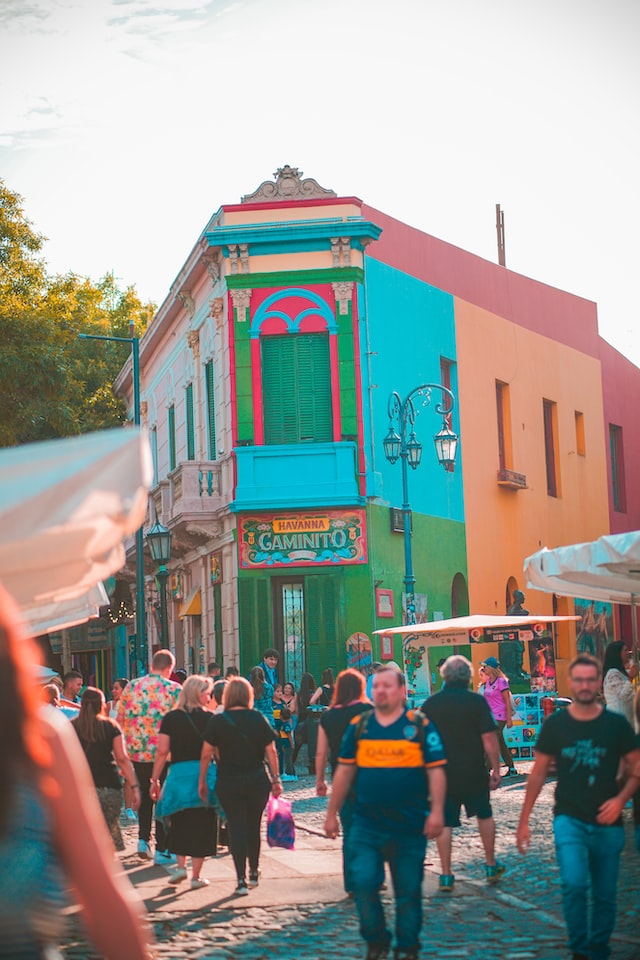
La Boca | Buenos Aires
La Boca
La Boca is a predominantly working class area of the city that is near to the Riachuelo river, it was once in the 19th century the port of the city where thousands of immigrants first set foot in Argentina. But today it is in fact inland from the River Plate. It has always had its social challenges but it’s an area you really should visit. However, just be sensible and remain in the tourist area around the very colourful Caminito part of the neighbourhood, where artists take there work onto the street in a explosion of colour as well as fun art works that cover the buildings, and small verandas of the buildings in this cobbled street area.
La Boca is an area you should see but do so during the daytime it’s not an area that it’s advisable to be in as a visitor during the hours of darkness.
San Telmo
San Telmo is another colourful neighbourhood in the city known for its colonial style buildings, art studios and galleries. It’s also home to the National Historical Museum which houses displays relating to Argentinian history. However, it is also a popular destination due to its boutique shops and Tango parlours and bars.
There is also a popular antiques market held every Sunday that draws crowds of shoppers. On the market front another place in San Telmo that is worth a walk around is the indoor Mercadio San Telmo. On the day we visited we got there by walking from the Plaza de Mayo along the street known as Boliver to San Telmo. It is a good 40 minute walk that gives you a flavour of the city. Once there we visited the Mercadio before enjoying a relaxing drink in the site of the Sunday Market which is a leafy tree lined plaza. Here we were treated to a Tango show by street performers.
Floralis Generica
This unusual and interesting sculpture made of steel and aluminum is found in the Plaza de las Naciones Unidas and was gifted to the city by the artist Edwardo Catalano. The huge sculpture is designed like a flower and it moves, opening in the morning and closing at night. It sits in the middle of a large green open space and is an interesting attraction.
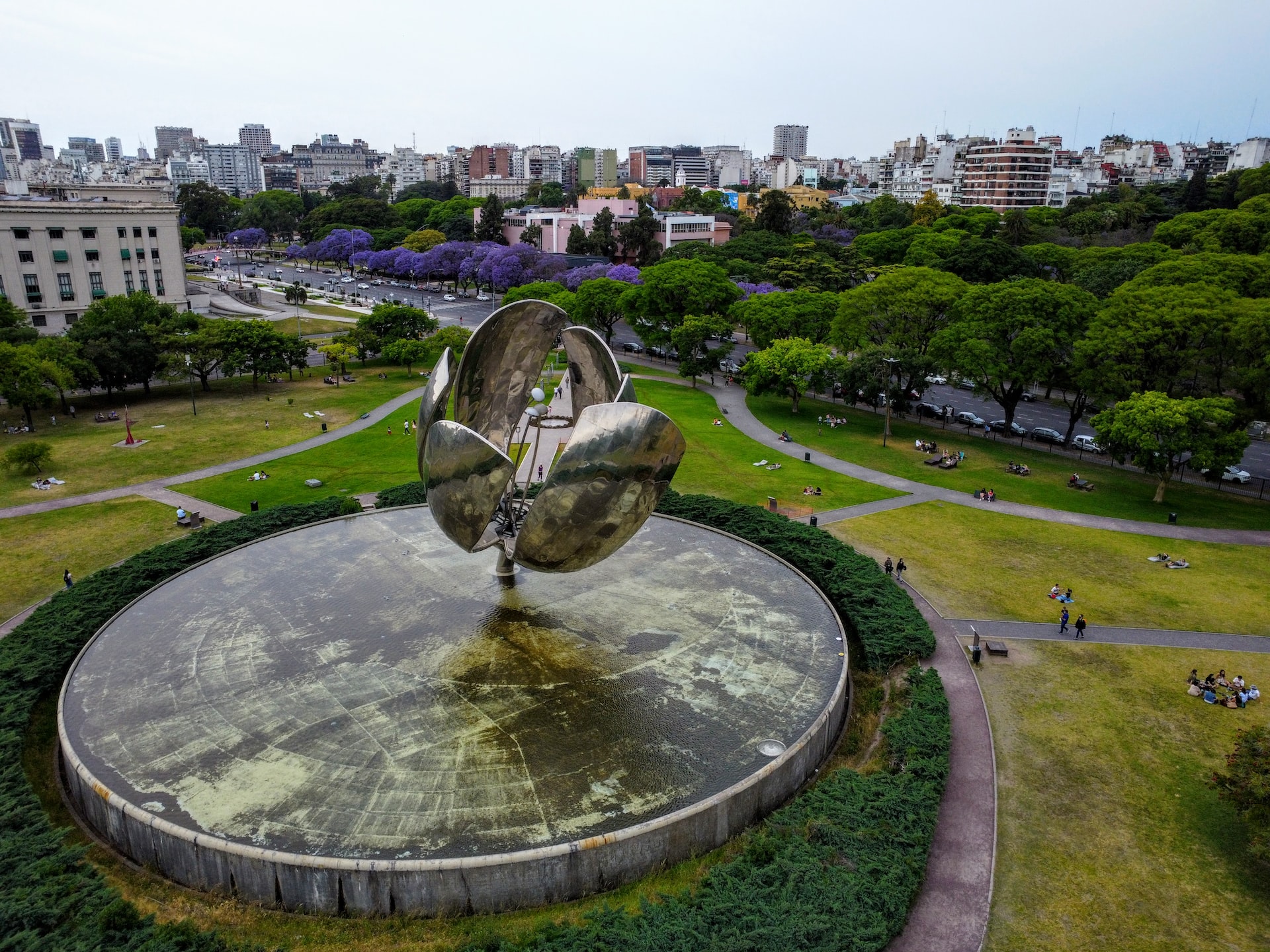
Floralis Generica | Buenos Aires
Corrientes Avenue
It’s the “street that never sleeps” and you can make your way through the city by wandering down it.
The bustling Avenida Corrientes passes through Microcentro, the financial district, across the pedestrian shopping street, Calle Florida, and by the Obelisco. There are countless bookshops, cafés, pubs, theatres, and shops along its edges.
If you don’t want to DIY it, there are walking tours that peruse the surrounding area which start around the National Congress.
Plaza Canada and Torre Monumental
The Plaza Canada is a lovely public square in the Retiro neighbourhood of the city. It’s a good place to have a relaxing walk around during the day however, it is not recommended to walk here during the hours of darkness. If you do visit you will find a Canadian totem pole that was a gift to the city from the Canadian ambassador. This is also where you will find the Torre Monumental. This was built by British residents in the city in 1909 and was to commemorate the then centenary of the Revolution. It was built in the form of a clock tower and you can visit it and see the inside of the tower where there is a small museum and some good views across the surrounding area.
Bosques de Palermo
You could describe this as Buenos Aires’ Central Park. It is a bit further away from other attractions in the city centre, so you will need to get a taxi here but it is worth the effort. This large park is split up into different areas of interest, such as small lakes with boats, Rose garden, a sculpture garden, jogging track, stands that rent out roller blades and bikes, etc. It covers over a 1000 acres so you have plenty to explore.
Tango Show
Well it really would be amiss if you were to visit Argentina and in particular Buenos Aires and not experience a Argentinian Tango Show. There are a number of venues that offer the full show accompanied by dinner and a drink. So we booked one of these and it as most do, came with transport to and from our hotel to the venue. Most hotels offer to book this for you but there are plenty of similar excursions on sale within the city and online.
The venues are all similar to small theatres with long tables. It’s worth noting these are popular with all visitors so the venues can be very busy, and they do use all the space so get there early for the best seats. However, it is a experience and one that I would recommend.
Museo Nacional de Bellas Artes
The Museum of Fine Arts in Buenos Aires is among the best in the world, with works by South American artists in addition to the big names like Van Gogh, Degas, Monet, and Picasso. Plus an added bonus is it’s free! The museum is found in the Recoleta area so it can be included with a visit to the famous Cemetery mentioned above. It is definitely worth a look around. They’ve got paintings, tapestries, carvings, and rotating temporary exhibits on display.
Puerto Madero
Puerto Madero is a modern neighbourhood which sits on the waterfront. It has numerous bars and restaurants and is a busy location for both locals and tourists socialising and enjoying this area.
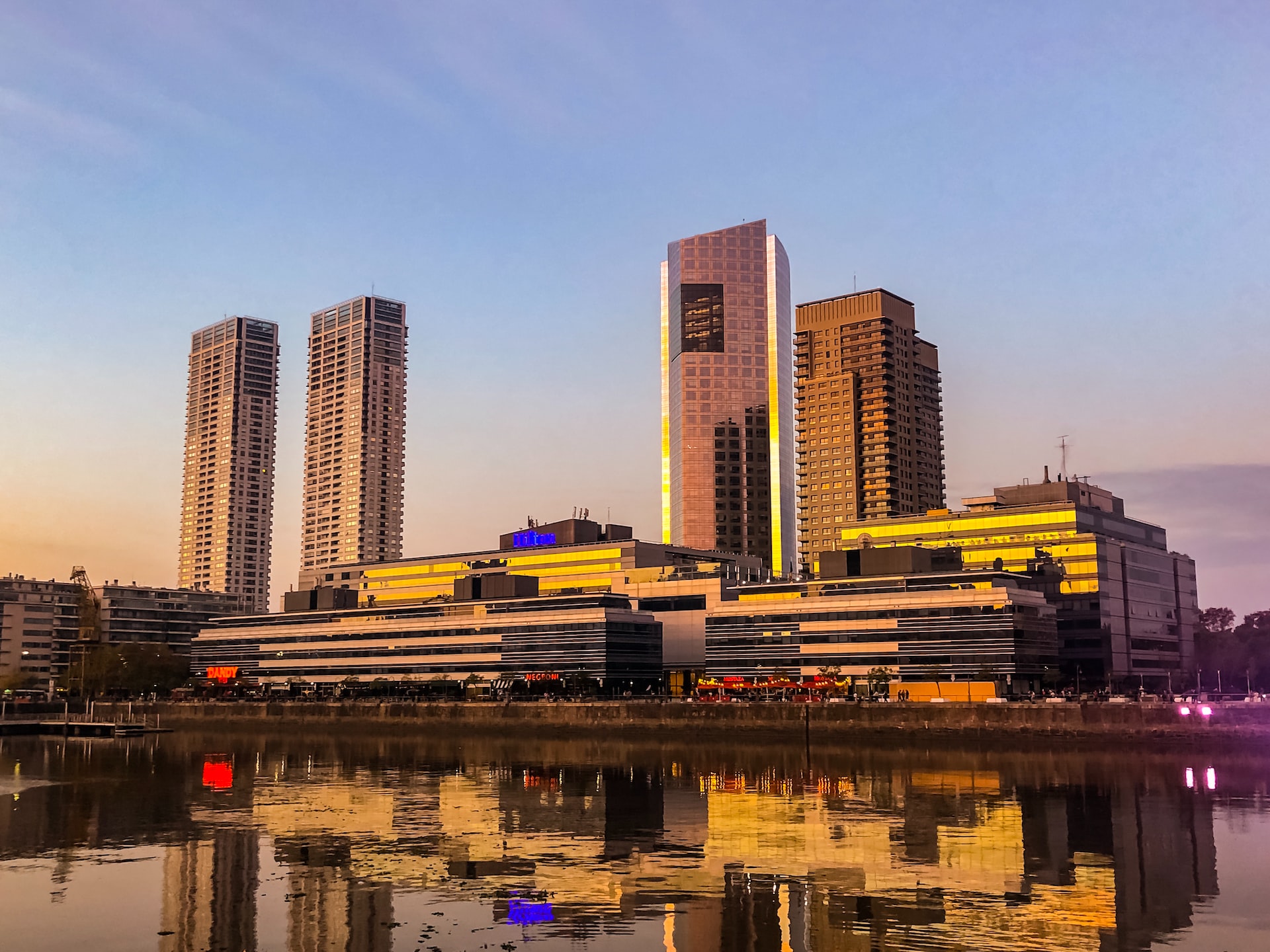
Puerto Madero | Buenos Aires
Argentinian Steak House
One thing Argentinian’s are proud of is their home reared beef. It is something the country is famous for. As a result, steak is a favourite dish of many restaurants and you will find Steak House restaurants all over the city. So again it was something we were keen to try and it did not dissapoint. We enjoyed a excellent meal and grilled steak at El Mirasol – a first class restaurant we found in the previously mentioned Puerto Madero neighbourhood.
Attend a Football Match
If there is one sport that the Argentinian’s love and excel at its Football, they are remember the current World Champions. However, their local professional football teams have let’s say passionate and dedicated supports. The rivalry is fierce and at times has spilled over to violent behaviour. But that aside the atmosphere of these games is intense. The two main teams are from Buenos Aires, River Plate & Boca Juniors.
As a visitor it is possible to experience a game as a spectator however, it is only really possible to do so through sanctioned Tour Guides & Companies who will arrange your visit and escort you to the game. They are online but be warned these experiences are expensive.
Well that is my tips and suggestions of what to see and experience in the busseling capital of Argentina, Buenos Aires. It was a city I had little knowledge of before we arrived there, but one that was full of surprises and one that was enjoyable and exciting. It is definitely a city worth a visit.
WORDS BY: TRAVEL THE WORLD AND SMILE HAPPY TRAVELLING WITH DAVIE


